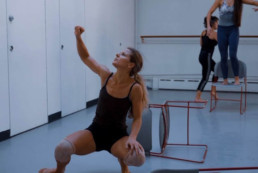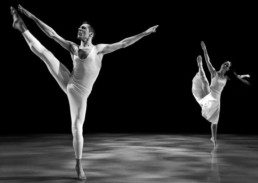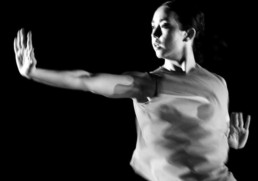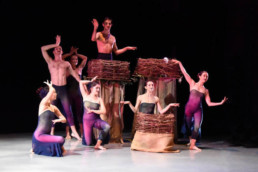Alison Cook-Beatty has choreographed a vast repertory of dances which explore the fundamentals of human life – relationships, nature, love, death, joy, anger, tragedy, and comedy to name just some. Her company’s Fall 2018 season at The Salvatore Capezio Theater at Peridance featured four original works, including one world premiere, which identified four different stories and themes to translate onto the dancing body.
The performance featured Alison Cook Beatty Dance’s eight company artists: Carolina Rivera, Fiona Oba, Timothy Ward, Niccolò Orsolani, Dorrie Silver, Vera Paganin, Nika Antuanette, and Jacob Brown. The show’s brilliant lighting design was by Tony Marques.
ACCUSED (VARIATION B) [2012] brought a stark opening to the evening. Musical scores by Philip Glass and Brian Eno, Tony Marques’ dark stage lighting, black and white school uniforms, and catastrophic subject material – elements intertwined with Alison Cook-Beatty’s choreography – shape the piece’s intensity. ACCUSED (VARIATION B) honors the children of Sandy Hook Elementary School in Connecticut. The dance also explores whether or not society encourages acts of violence and hatred.
Ironically, this latter question brings to mind the heavy political week America experienced just one week prior to Alison Cook-Beatty’s Fall Season. America saw the deadliest attack on the Jewish community in history. A wave of mail bombs were sent to critics of President Donald Trump. Halloween brought the one year anniversary of the deadly terrorist truck driver attack which killed eight and injured dozens in Lower Manhattan. The dance brought these events, and countless others, to mind – though they were fresh in my mind regardless. ACCUSED (VARIATION B) further drove my speculation as to where this hate stems from.
Nika Antuanette danced the role of The Odd Child Out alongside the other seven dancers, The Classmates. Nika was in total command of her character. We see an almost manic side to her, appropriate for her role, as she whips across the stage. She executes her dance material – ripe with turns, slashing arm movements, and hand gestures that look like painting or writing – with a power so large it causes a reverberation in her classmates, who flee and literally duck for cover. The Classmates knock over all of the chairs which were originally placed in a well-organized manner on the downstage right side of the stage. As The Classmates cowered, the audience gripped their own chairs as if they might be knocked over as well.
Second on the program was LIFELINE (2002), a duet danced by Niccolò Orsolani and Carolina Rivera, to the peaceful score of Adiemus Variations I-III by Karl Jenkins. The pair wore elegant white costumes, and danced together with the same grace and purity. As indicated by the title, the pair appeared heavily dependent on one another. When not dancing in physical contact – we see angelic lifts and affectionate embraces, emphasized by both balletic and classic modern dance techniques – the two split into the upstage left and right to continue dancing on their own. When apart, Niccolò and Carolina still maintained a balanced, complimentary relationship. Niccolò and Carolina evoked a sort of yin-yang image in my mind, in the way that their two parts make up a coherent whole. This whole is clearly love, as the two are clearly a pair that rely on one another to function both efficiently and with passionate urgency. They appear neither gleeful nor melancholy, simply focused on each other.
MAGNETIC TEMPTATIONS (World Premiere) was a twenty-four minute whirlwind. Though fast-paced and ripe with intricate gestures and phrase work, Alison Cook-Beatty incorporated clear recurring motifs which brought a subtle sense of calm. The premiere began with a male soloist, Timothy Ward, who we see in a sheer tank top and long pants (the costumes appear in shades of tan, gray and beige depending on the stage lighting). He introduces a phrase that seems to literally paint the space with his arm movements and circular walking patterns, as well as bring a sprightly energy with sauté jumps in retiré, arms held on the diagonal. Moments of Timothy dancing alone would recur through the piece. Timothy, still center and the only dancer standing, is eventually joined by a trio of dancers behind him who are low to the ground – and then by a duet which nimbly travels from upstage left to downstage right. Timothy seems to anchor the stage, though as rapidly as all of this occurs, we see the dancers interweave in various unison phrases and depart to allow other solo and duet phrases to appear on stage alone.
MAGNETIC TEMPTATIONS was indicative of several themes: I saw community action, pleas for change, defiance, challenge, and exasperation. And prior to the dance, the audience was informed that the dance also nods to love, toxic relationships and environmental sustainability (by Gerald Appelstein, President of the Alison Cook Beatty Dance Board). I only wish I could see it a second time! The piece had a juxtaposition of groundedness – the dancers executed several phrases with definitive stomps, knee work, and weighted musculature – and flight, which had dancers lifted by the entire group at times, or shooting like stars across the stage.
Carolina Rivera shines in this piece. She often would dance front and center of group unison sections, though even when her placement was not so centered, her focus and physicality were exceedingly direct, intense, and commanding. In moments in the latter half of the piece, the entire cast is standing with their focus out towards the audience – most striking was Carolina’s gaze, as I saw her eyes literally boring through the house. Her gaze was emphasized by her weight shifted forward onto the balls of her feet, with her arms held strongly at her side. She was ready for action.
MURMURATION (2016) closed the program on a [fluttering] high note. Ottorino Respighi’s cheerful score Gli uccelli (The Birds) carried the dancers through eighteen minutes of joyful flocking and frolicking. The term “murmuration,” which is defined as a flock of starlings, indicates group harmony in itself, and that is exactly what Alison Cook-Beatty’s choreography achieved in this work. Set on the entire company, we see a dove (Vara Paganin), a chicken (Jacob Brown), a nightingale (Carolina Rivera), two cuckoos (Niccolò Orsolani and Fiona Oba) and three starlings (Nika Antuanette, Dorrie Silver and Timothy Ward) coexisting in their shared nest – the dancers literally could position themselves inside of a radiant handmade set design of birds nests by Daniel G. Cook, which sat in the upstage left corner – and world beyond.
Through quick-paced, balletic phrase work lush with petite jumps and grande jumps alike, the dancers embodied their avian characters. And sometimes, the eight birds nestled into the floor in a formal, yet birdlike, seated position. Their arms, hands, wrists, and fingers were held like wings, framing their bodies with gentle flaps and flutters, while their feet moved briskly. If a human could fly, this was the way. In group sections, I was especially awed by Fiona Oba, whose stellar technique and peaceful focus stretched beyond her wingspan. I also must applaud the gorgeous costume design by Christine Darch. The female dancers were dressed in fitted purple and green unitards with a wing-like fabric attached to their legs that hung just like feathers. The men’s legs were identical to the females’, only they were bare chested. The costume brought on a natural, formal, and beautiful aesthetic.
Alison Cook-Beatty does it again – a striking evening of classical and contemporary dance, giving the audience much to consider.
Author: Kristen Hedberg
Source: http://www.kristenhedberg.org/performance-reviews/alison-cook-beatty-dance-shines-at-peridance-in-2018-fall-season





